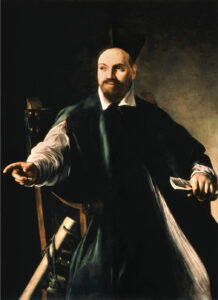A Caravaggio portrait of a young pope, first positively attributed to the artist over six decades ago, has finally gone on public display for the first time ever.
Caravaggio created the portrait of Maffeo Barberini around 1598 when the priest was around 30 years old. He sits in a chair dressed simply in a green cassock and a black hat, holding a letter in his left hand. Most interestingly, though, Barberini looks off to the side and gestures with his other hand in the same direction, possibly interacting with some unseen person out of view. The painting is significant from an art-historical perspective because it’s so rare. Caravaggio was no stranger to figure painting, but few of his portraits survive today. The portrait remained with the Barberini family until the 1930s, with the current owners first acquiring it in the 1960s. It was first attributed to Caravaggio in 1963 when the art historian Roberto Longhi published his opinion in the academic journal Paragone. Longhi described the portrait as an example of “realtà atteggiata”, or staged reality. Caravaggio has taken a rather static art form, portraiture, and imbued it with action, with Barberini’s face and hand indicating movement and narrative elements. Barberini seemed pleased with the painting since he later commissioned Caravaggio to create a religious scene, The Sacrifice of Isaac, completed in 1603 and now housed at the Uffizi Gallery. The portrait went on display this past Saturday, November 23rd, as part of an exhibition at the Palazzo Barberini that will run through February 23, 2025.
Barberini became acquainted with Caravaggio through the artist’s patron, the Cardinal Francesco Maria del Monte. Barberini came from an influential Tuscan family that made their fortune as grain and wool merchants. They later used their money to buy church offices and gain social and political power. The family reached the pinnacle of its power through Maffeo, the subject of the Caravaggio portrait. He was a Jesuit-educated priest who would climb the ranks of the church to become the pope’s ambassador to France and then a cardinal. In 1623, Barberini was elected to the papacy under the name Urban VIII. During his rise to power, Barberini acquired an extensive list of assets, including art and property. He became a patron for many seventeenth-century artists like Bernini, da Cortona, Poussin, and Lorrain. Today, one of his residences in Rome, the Palazzo Barberini, houses one of the two locations of the Gallerie Nazionali di Arte Antica, one of the city’s great museums and Italy’s preeminent cultural institution dedicated to Old Master paintings.
There are still some questions as to the portrait’s provenance or if the subject is, in fact, Barberini. But now scholars and specialists have the painting in a controlled museum environment to study it and help fill in the still-vacant gaps in Caravaggio’s life and work. It may even help determine the authorship of another alleged Barberini portrait by Caravaggio at Rome’s Palazzo Corsini, the museum’s second location. After the exhibition closes, the museum will return the painting to its owners in Florence.

